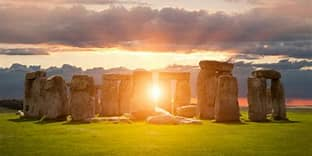Search This Blog
An Environmental website whose primary focus is to help everyone understand the impact humans have on the physical environment with resources that help us achieve what we call a safe and clean environment.
Featured
- Get link
- X
- Other Apps
Unveiling the Mysteries: 10 Ancient Monuments Oriented Towards the Solstices
Welcome to a captivating journey through time as we explore the marvels of ancient civilizations and their incredible knowledge of astronomy. In this blog post, we will dive into the world of ancient monuments that were ingeniously designed to align with the solstices – the two significant moments in the Earth's annual orbit around the Sun. These monuments stand as a testament to the deep connection our ancestors had with the cosmos and their profound respect for nature. Join us as we unveil the mysteries and discover ten remarkable ancient sites that continue to astound and inspire us today.
1. Stonehenge, England:
 |
| Stonehenge in Wiltshire, England |
2. Newgrange, Ireland:
 |
| Newgrange in County Meath, Ireland |
Journeying to Ireland, we encounter the awe-inspiring Neolithic monument of Newgrange. This extraordinary passage tomb is renowned for its precise alignment with the winter solstice. Each year, the rising sun illuminates a narrow passage, flooding the inner chamber with ethereal light, signifying rebirth and the cyclical nature of life.
Newgrange is a prehistoric monument located in County Meath in Ireland. It is an exceptionally grand passage tomb built during the Neolithic Period, around 3200 BC, making it older than Stonehenge and the Egyptian pyramids.
(1) Newgrange | Wikipedia. https://en.wikipedia.org/wiki/Newgrange.
(2) Newgrange Stone Age Passage Tomb | Boyne Valley, Ireland. https://www.newgrange.com/.
(3) Brú na Bóinne Visitor Centre (Newgrange and Knowth) | Heritage Ireland. https://heritageireland.ie/places-to-visit/bru-na-boinne-visitor-centre-newgrange-and-knowth/.
3. Chichen Itza, Mexico:
 |
| Chichen Itza in Yucután Peninsula, Mexico |
Crossing continents, we venture to Chichen Itza, a remarkable ancient Mayan city in Mexico. The focal point of this archaeological marvel is the grand pyramid, El Castillo. On the spring and autumn equinoxes, the sunlight casts a mesmerizing shadow that resembles a serpent descending the pyramid's steps, an astonishing celestial spectacle.
Chichén Itzá is one of the most visited archaeological sites in Mexico and is a UNESCO World Heritage Site. It is located in the Yucatán Peninsula of Mexico and was a large pre-Columbian city built by the Maya civilization.
Chichen Itza | Wikipedia. https://en.wikipedia.org/wiki/Chichen_Itza.
Chichen Itza | Description, Buildings, History, & Facts. https://www.britannica.com/place/Chichen-Itza.
Chichén Itzá | Wikipedia, la enciclopedia libre. https://es.wikipedia.org/wiki/Chich%C3%A9n_Itz%C3%A1.
Chichen Itza | World Heritage Site | National Geographic. https://www.nationalgeographic.com/travel/world-heritage/article/chichen-itza.
4. Machu Picchu, Peru:
 |
| Machu Pichu in Peru |
5. Goseck Circle, Germany:
 |
| Goseck Circle in Saxony-Anhalt, Germany. |
Returning to Europe, we encounter the Goseck Circle in Germany, a fascinating archaeological discovery. This circular structure was an astronomical observatory dating back to the Neolithic period. Its openings were precisely aligned with the solstices, allowing ancient observers to track the Sun's movement throughout the year.
The Goseck Circle is a Neolithic structure located in Goseck in the Burgenlandkreis district in Saxony-Anhalt, Germany. Its construction is dated to approximately 4900 B.C. and appears to have remained in use until about 4700 B.C. It is considered to be the oldest and best-known of the circular enclosures associated with the Central European Neolithic.
Goseck Circle - Wikipedia. https://en.wikipedia.org/wiki/Goseck_circle.
Goseck Circle. http://sonnenobservatorium-goseck.info/.
Goseck Circle. https://bing.com/search?q=Goseek+Circle+Germany.
Goseck Circle – Goseck, Germany - Atlas Obscura. https://www.atlasobscura.com/places/goseck-circle.
Goseck Circle, Goseck, Germany - SpottingHistory.com. https://www.spottinghistory.com/view/5165/goseck-circle/.
6. Abu Simbel, Egypt:
 |
| Abu Simbel in Aswan Governorate, Egypt |
Let's now delve into the wonders of ancient Egypt, where the colossal temple complex of Abu Simbel leaves us in awe. Twice a year, during the solstices, the rising sun penetrates the temple's inner sanctum, illuminating the statues of the Pharaoh Ramses II and the gods seated within, showcasing the remarkable architectural and astronomical prowess of the ancient Egyptians.
Abu Simbel is a historic site comprising two massive rock-cut temples in the village of Abu Simbel (Arabic: أبو سمبل), Aswan Governorate, Upper Egypt, near the border with Sudan. It is situated on the western bank of Lake Nasser, about 230 km (140 mi) southwest of Aswan (about 300 km (190 mi) by road). The two temples, comprising the site, were created during the reign of Ramesses II (c. 1279 - c. 1213 BCE) either between 1264 - 1244 BCE or 1244-1224 BCE.
Abu Simbel - Wikipedia. https://en.wikipedia.org/wiki/Abu_Simbel.
Abu Simbel - World History Encyclopedia. https://www.worldhistory.org/Abu_Simbel/.
Abu Simbel | History, Temples, Map, & Images | Britannica. https://www.britannica.com/place/Abu-Simbel.
7. Maeshowe, Scotland:
 |
| Maeshowe in Orkney, Scotland |
Hidden within the rugged landscape of Orkney, Scotland, lies the ancient chambered tomb of Maeshowe. This remarkable structure, built around 5,000 years ago, aligns perfectly with the setting sun during the winter solstice. Witnessing the sun's rays penetrate the tomb's entrance is a truly magical experience.
Maeshowe is a Neolithic chambered cairn and passage grave situated on Mainland Orkney, Scotland. It was probably built around 2800 BC. It is aligned in various ways with other Neolithic sites in the Orkneys; the entrance to the Barnhouse settlement directly faces Maeshowe, the entrance of which points to the Barnhouse Stone.
Maeshowe - Wikipedia. https://en.wikipedia.org/wiki/Maeshowe.
Maeshowe – Orkney, Scotland - Atlas Obscura. https://www.atlasobscura.com/places/maeshowe.
Maeshowe - https://bing.com/search?q=Maeshowe+in+Scotland.
Maeshowe. https://www.historicenvironment.scot/visit-a-place/places/maeshowe-chambered-cairn.
Maeshowe in Scotland, UK | Sygic Travel. https://travel.sygic.com/en/poi/maeshowe-poi:7764.
8. Angkor Wat, Cambodia:
 |
| Angok Wat in Cambodia |
Prepare to be enchanted by the breathtaking beauty of Angkor Wat, the world's largest religious monument. Constructed in the 12th century, this marvel of Khmer architecture incorporates celestial alignments. The sun rises directly behind the central tower during the winter solstice, creating an ethereal spectacle.
Angkor Wat is a temple complex in Cambodia, located on a site measuring 162.6 hectares (1,626,000 m2; 402 acres). It was originally built in the first half of the 12th century as a Hindu temple. Spread across more than 400 acres, Angkor Wat is said to be the largest religious monument in the world. It was built at the behest of the Khmer King Suryavarman II in the early 12th century in Yaśodharapura (Khmer: យសោធរបុរៈ, present-day Angkor), the capital of the Khmer Empire, as his state temple and eventual mausoleum.
Angkor Wat | Wikipedia. https://en.wikipedia.org/wiki/Angkor_Wat.
Angkor Wat | HISTORY. https://www.history.com/topics/landmarks/angkor-wat.
Angkor Wat | Description, Location, History, Restoration, & Facts. https://www.britannica.com/topic/Angkor-Wat.
9. Callanish Stones, Scotland:
 |
| Callanish Stones on the west coast of the Isle of Lewis in Scotland |
Situated on the Isle of Lewis, the Callanish Stones stand as a mesmerizing testament to ancient wisdom. Dating back to the Bronze Age, this stone circle is aligned with the midwinter sunset, creating a captivating spectacle as the dying rays of the sun paint the landscape with an otherworldly glow.
The Callanish Stones are an arrangement of standing stones placed in a cruciform pattern with a central stone circle. They were erected in the late Neolithic era and were a focus for ritual activity during the Bronze Age. The stones are located on the west coast of the Isle of Lewis in Scotland.
Callanish Stones - Wikipedia. https://en.wikipedia.org/wiki/Callanish_Stones.
Callanish Standing Stones, Scotland (with Map & Photos) - Tourcounsel. https://www.tourcounsel.com/2021/10/callanish-stones-scotland.html.
Callanish Stones - https://bing.com/search?q=callanish+Stones+scotland.
Callanish Stones - http://www.callanishvisitorcentre.co.uk/index.php/features.
Callanish Stones - How to Visit Craigh na Dun, the Iconic "Outlander" Stones - Oprah Daily. https://www.oprahdaily.com/entertainment/tv-movies/a30505267/real-craigh-na-dun-outlander/.
10. Tulum, Mexico:
 |
| Tulum in Riviera Maya, Mexico |
Our final stop takes us to the breathtaking coastal ruins of Tulum in Mexico. Perched on a cliff overlooking the Caribbean Sea, Tulum's Temple of the Frescoes is believed to have served as an observatory for tracking celestial events. During the summer solstice, the rising sun aligns perfectly with a temple window, highlighting the deep astronomical knowledge possessed by the Mayans.
Tulum is a town on the Caribbean coastline of Mexico's Yucatán Peninsula. It is known for its beaches and the well-preserved ruins of an ancient Mayan port city. The ruins are situated on 12-meter-tall cliffs along the east coast of the Yucatán Peninsula on the Caribbean Sea.
There are many things to do in Tulum such as visiting the LabnaHa Eco Park where you can hike through dense jungle and explore a subterranean river. You can also visit the ancient seaside ruins.
Tulum - Wikipedia. https://en.wikipedia.org/wiki/Tulum.
Tulum, Mexico 2023: Best Places to Visit - Tripadvisor. https://www.tripadvisor.com/Tourism-g150813-Tulum_Yucatan_Peninsula-Vacations.html.
Tulum Travel - Lonely Planet | Mexico, North America. https://www.lonelyplanet.com/mexico/yucatan-peninsula/tulum.
Conclusion:
As we conclude our journey through time, we are left in awe of the ingenuity, spiritual devotion, and profound connection ancient civilizations had with the cosmos. These ten ancient monuments oriented towards the solstices not only served as celestial observatories but also embodied a deep respect for nature and the environment. They stand as reminders of the incredible knowledge and wisdom our ancestors possessed, inspiring us to appreciate the wonders of the natural world and seek a harmonious relationship with our environment. Let us continue to marvel at these ancient sites, preserving their legacy and the lessons they hold for future generations.
So, prepare to be transported to a realm where the solstices and ancient marvels intertwine. Join us on this engaging and enlightening journey, as we explore the ancient monuments that have stood the test of time and remain captivating testaments to the wonders of the universe.
- Get link
- X
- Other Apps
Popular Posts
Environmentally Persistent Pharmaceutical Pollutants (EPPPs): A Growing Threat to Our Ecosystems
- Get link
- X
- Other Apps
Circular Economy Important Websites You Should Look At
- Get link
- X
- Other Apps

Comments
Post a Comment